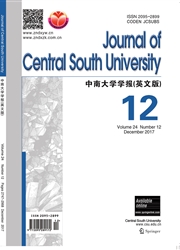

 中文摘要:
中文摘要:
In order to simulate and study the mechanism of cement stabilized soils polluted by different contents of magnesium sulfate(MS), a series of tests were conducted on the cemented soil samples, including unconfined compression strength(UCS) tests of blocks, X-ray diffraction(XRD) phase analysis of powder samples, microstructure by scanning electronic microscopy(SEM),element composition by energy dispersive spectrometry(EDS), and pore distribution analysis by Image Processed Plus 6.0(IPP 6.0)software. The UCS test results show that UCS of cemented soils reaches the peak value when the MS content is 4.5 g/kg. While, the UCS for Sample MS4 having the MS content of 18.0 g/kg is the lowest among all tested samples. Based on the EDS analysis results,Sample MS4 has the greater contents for the three elements, oxygen(O), magnesium(Mg) and sulfur(S), than Sample MS1. From the XRD phase analysis, C-A-S-H(3Ca O·Al2O3·3Ca SO4·32H2O and 3Ca O·Al2O3·Ca SO4·18H2O), M-A-H(Mg O·Al2O3·H2O), M-S-H(Mg O·Si O2·H2O), Mg(OH)2 and Ca SO4 phase diffraction peaks are obviously intense due to the chemical action associated with the MS. The pore distribution analysis shows that the hydrated products change the distribution of cemented soil pores and the pores with average diameter(AD) of 2-50 μm play a key role in terms of the whole structure of cemented soil. The microscopic structure of the cemented soil with MS exhibits the intertwined and embedded characteristics between the cement and granular soils from the SEM images of cemented soils. The microstructure analysis shows that the magnesium sulfate acts as the additive, which is beneficial to the soil strength when the MS content is low(i.e., Sample MS2). However, higher MS amount involving a chemical action makes samples crystallize and expand, which is adverse to the UCS of cemented soils(i.e., Sample MS4).
 英文摘要:
英文摘要:
In order to simulate and study the mechanism of cement stabilized soils polluted by different contents of magnesium sulfate(MS), a series of tests were conducted on the cemented soil samples, including unconfined compression strength(UCS) tests of blocks, X-ray diffraction(XRD) phase analysis of powder samples, microstructure by scanning electronic microscopy(SEM),element composition by energy dispersive spectrometry(EDS), and pore distribution analysis by Image Processed Plus 6.0(IPP 6.0)software. The UCS test results show that UCS of cemented soils reaches the peak value when the MS content is 4.5 g/kg. While, the UCS for Sample MS4 having the MS content of 18.0 g/kg is the lowest among all tested samples. Based on the EDS analysis results,Sample MS4 has the greater contents for the three elements, oxygen(O), magnesium(Mg) and sulfur(S), than Sample MS1. From the XRD phase analysis, C-A-S-H(3Ca O·Al2O3·3Ca SO4·32H2O and 3Ca O·Al2O3·Ca SO4·18H2O), M-A-H(Mg O·Al2O3·H2O), M-S-H(Mg O·Si O2·H2O), Mg(OH)2 and Ca SO4 phase diffraction peaks are obviously intense due to the chemical action associated with the MS. The pore distribution analysis shows that the hydrated products change the distribution of cemented soil pores and the pores with average diameter(AD) of 2-50 μm play a key role in terms of the whole structure of cemented soil. The microscopic structure of the cemented soil with MS exhibits the intertwined and embedded characteristics between the cement and granular soils from the SEM images of cemented soils. The microstructure analysis shows that the magnesium sulfate acts as the additive, which is beneficial to the soil strength when the MS content is low(i.e., Sample MS2). However, higher MS amount involving a chemical action makes samples crystallize and expand, which is adverse to the UCS of cemented soils(i.e., Sample MS4).
 同期刊论文项目
同期刊论文项目
 同项目期刊论文
同项目期刊论文
 期刊信息
期刊信息
